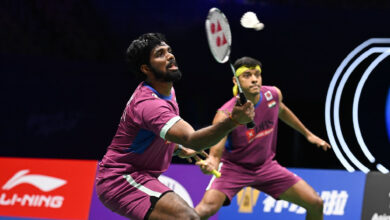How overspin makes Ravichandran Ashwin more effective abroad than Ravindra Jadeja, explains Sunil Joshi

R Ashwin had the air of a man who has endured one too many swings of misfortune, despite having more than 700 international wickets; somehow the off-spinner has always been on the chopping board. One of the most cliche adages in cricket is “let the bat do the talking.” It’s a batsman game, afterall but in Ashwin’s case, it is different, he has always let his bowling do the talking.
Ashwin, ranked No 1 in the world, couldn’t find a place in the playing XI for last month’s World Test Championship (WTC) final against Australia. He spoke at length about how he felt about the omission and why he was also prepared for not playing in the final. But the master spinner has started the next WTC cycle in style, picking up 12 wickets in the first Test against West Indies, who looked like a club-level team. The West Indies batsmen are definitely not at the level of Steve Smith, Usman Khawaja, and Travis Head, and it would be unfair to extrapolate that having Ashwin at The Oval would have brought a different result. But the off-spinner displayed all the wares at his disposal to prove that he can make a positive difference to any attack.
“When an athlete is willing to work hard, willing to learn the art of spin, it doesn’t matter which format he plays. A good ball is a good ball, a half-tracker or a full toss is a bad ball in any format of the game,” former India spinner Sunil Joshi tells The Indian Express.
West Indies had no answer to Ashwin’s magic. Here are all 5 of his wickets 🔥#WIvIND #INDvWIonFanCode pic.twitter.com/l6X6wFBxe0
— FanCode (@FanCode) July 13, 2023
Joshi explains why Ashwin is one of the few spin bowlers in the world alongside Nathan Lyon, who relies on overspin and what makes him so good across formats and conditions.
“You need to have a repeatable action and you can build consency over a period of time. Everytime when the ball is hit over the sight screen it is a length ball. And every time a ball is hit horizontally, it is a short ball. How many times a bowler gets hit over the umpire, it is very rare compared to the horizontal shots. This is where Ashwin excels, how many batsmen in the world can dance down the track? Very few,” he says.
Joshi says what makes Ashwin dangerous is the way he plays with the mind of a batsman, be it the leg-side trap against Smith and Marnus Labuschagne or cleaning up Alastair Cook with classical off-spin at Edgbaston.
“How does he do that? Pretty simple: putting an extra revolution on the ball. For that ball has to go in the air, dip, come down and the batsman needs to step out, reach the ball and play with the spin, or against the spin. Every ball differs from the revolutions in the air and after pitching, it changes direction based on the surface where it lands, be it on the seam or on the shiny part. He gets that drift that goes away from the right-hander as well as the left hander.”
Joshi admits that Ashwin’s understanding of the game and its dynamics are second to none.
“He understands the dynamics. How, why and what? He knows he needs to put more revolution to the ball and it doesn’t matter if it is a red ball, white ball or orange ball. A spinner needs to spin the ball, doesn’t matter if it is at international level, domestic level or club level. Put revolutions in the ball and be consent on the hard length with a repeatable action to master it. This is what Ashwin does,” he says.
There has also been debate on the speed guns of spinners. After Graeme Swann and Monty Panesar’s exploits in India in 2012, the then skipper MS Dhoni said we need spinners, who can bowl quicker. Ravindra Jadeja was handed the debut and the left-arm spinner on turning track is menace to face but overseas, he is being reduced to someone captains used to correct the over rate.
“It’s not quick bowling. It is bowling on the seam. When you bowl on the seam and hit the shiny part, it drifts,and when it hits the seam part it bounces. Panesar and Swann were successful because they started bowling overspin. In India overspin is the key and wherever you go overspin is the key.
“Why is Nathan Lyon successful across the world? Because he bowls overspin. Why is Ashwin successful? Because he bowls overspin. Why Jadeja and Axar Patel are not successful in overseas conditions or where the wicket doesn’t help.
“A spinner need not depend on the surface. On a turning track, you don’t need to tell anyone how to bowl, where to bowl and why to bowl. Those questions will only come when you bowl on a good batting wicket, a good Test match wicket. A spinner should understand on Day 1 of the Ranji Trophy or the Test match cricket what sort of line and length one has to bowl and with what field. It alters each day of a Test and it is also important how and where to bowl to the top five or six batsmen. What is his shot selections and where to bowl to the tailenders. Ashwin ticks all those boxes,” says Joshi.







